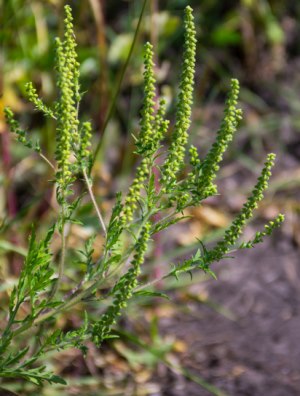Ragweed Plants Packed with Pollen
 Summer fun can turn to fall misery for millions of people who suffer from seasonal allergic rhinitis (hay fever). Sneezing, stuffy or runny nose, itchy eyes, nose and throat, or worsening of asthma symptoms are common in people with undiagnosed or poorly managed hay fever.
Summer fun can turn to fall misery for millions of people who suffer from seasonal allergic rhinitis (hay fever). Sneezing, stuffy or runny nose, itchy eyes, nose and throat, or worsening of asthma symptoms are common in people with undiagnosed or poorly managed hay fever.
The primary culprit of fall allergies is ragweed pollen. A ragweed plant only lives one season, but it packs a powerful punch. A single plant can produce up to 1 billion pollen grains. These grains are very light weight and float easily through the air.
Fall allergy symptoms used to start in mid-August and run through September. However in many parts of the country these symptoms now begin in early August and extend through October. Some studies suggest that rising temperatures and higher carbon dioxide levels contribute to longer growth time of allergen-producing plants.
Allergies occur when the body’s immune system treats the allergen, in this case ragweed, as a foreign invader. This starts a chemical reaction which produces and sends histamine throughout the blood stream. These chemicals cause allergy symptoms to develop.
Controlling symptoms
Proper diagnosis is the first step in managing your symptoms. An allergist/immunologist will give a physical exam, ask about your health history and perform allergy testing to determine exactly what you are and are not allergic to.
Although there is no cure, ragweed allergy can be managed to improve the quality of your life.
The best control is to avoid contact with the pollen. This can be difficult, but resources are available. The National Allergy BureauTM (NAB) tracks pollen counts regionally to help you plan when you should avoid spending a lot of time outdoors.
Talk to your doctor about medications that may provide temporary relief from symptoms. Your allergist/immunologist may also recommend immunotherapy (allergy shots) or sublingual immunotherapy (SLIT) allergy tablets, treatment. This long-term treatment approach can significantly reduce the frequency and severity of symptoms caused by allergic rhinitis.
Did you know?
• The tall goldenrod species of ragweed gets blamed for most of the pollen, but a primary cause of allergy symptoms is the tooth-leaved ragweed that lives low in the grass.
• Ragweed can be found in almost all states in the United States as well as in Canada.
• An accurate diagnosis is essential for managing symptoms. Allergy testing performed by an allergist can determine what you are and not allergic to.
To the point
Although often associated with hay fever, ragweed can also cause skin conditions such as allergic contact dermatitis and hives.
Find out more about hay fever.
The AAAAI's Find an Allergist / Immunologist service is a trusted resource to help you find a specialist close to home.
Podcasts Episode: Seasonal Allergies, COVID-19, and the Common Cold: A Trifecta of Autumn Overlap

Anne Ellis, MD, FRCPC, FAAAAI, offers excellent tips on how to tell the difference between three different causes of similar symptoms this autumn. Listen to this episode to learn practical advice on how to differentiate symptoms from seasonal allergies, the common cold, and COVID-19. (September 11, 2020)
Click here to listen to the podcast.
1/10/2024